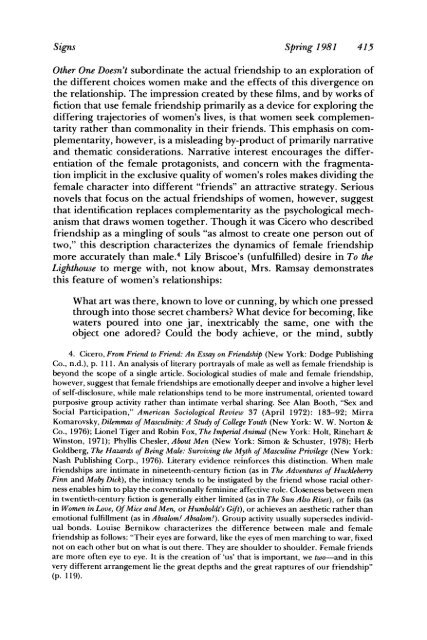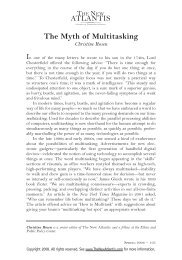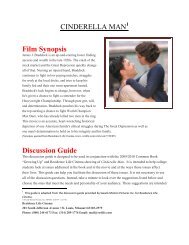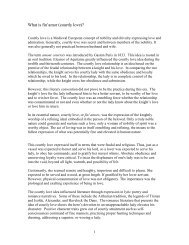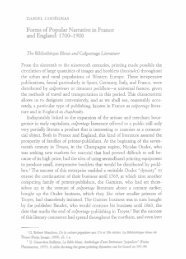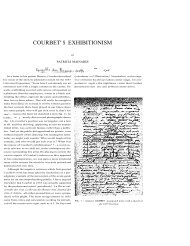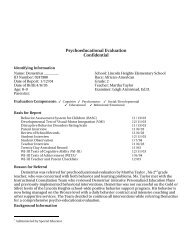(E)Merging Identities: The Dynamics of Female Friendship in ...
(E)Merging Identities: The Dynamics of Female Friendship in ...
(E)Merging Identities: The Dynamics of Female Friendship in ...
Create successful ePaper yourself
Turn your PDF publications into a flip-book with our unique Google optimized e-Paper software.
Signs Spr<strong>in</strong>g1981 415<br />
Other One Doesn't subord<strong>in</strong>ate the actual friendship to an exploration <strong>of</strong><br />
the different choices women make and the effects <strong>of</strong> this divergence on<br />
the relationship. <strong>The</strong> impression created by these films, and by works <strong>of</strong><br />
fiction that use female friendship primarily as a device for explor<strong>in</strong>g the<br />
differ<strong>in</strong>g trajectories <strong>of</strong> women's lives, is that women seek complementarity<br />
rather than commonality <strong>in</strong> their friends. This emphasis on complementarity,<br />
however, is a mislead<strong>in</strong>g by-product <strong>of</strong> primarily narrative<br />
and thematic considerations. Narrative <strong>in</strong>terest encourages the differentiation<br />
<strong>of</strong> the female protagonists, and concern with the fragmentation<br />
implicit <strong>in</strong> the exclusive quality <strong>of</strong> women's roles makes divid<strong>in</strong>g the<br />
female character <strong>in</strong>to different "friends" an attractive strategy. Serious<br />
novels that focus on the actual friendships <strong>of</strong> women, however, suggest<br />
that identification replaces complementarity as the psychological mechanism<br />
that draws women together. Though it was Cicero who described<br />
friendship as a m<strong>in</strong>gl<strong>in</strong>g <strong>of</strong> souls "as almost to create one person out <strong>of</strong><br />
two," this description characterizes the dynamics <strong>of</strong> female friendship<br />
more accurately than male.4 Lily Briscoe's (unfulfilled) desire <strong>in</strong> To the<br />
Lighthouse to merge with, not know about, Mrs. Ramsay demonstrates<br />
this feature <strong>of</strong> women's relationships:<br />
What art was there, known to love or cunn<strong>in</strong>g, by which one pressed<br />
through <strong>in</strong>to those secret chambers? What device for becom<strong>in</strong>g, like<br />
waters poured <strong>in</strong>to one jar, <strong>in</strong>extricably the same, one with the<br />
object one adored? Could the body achieve, or the m<strong>in</strong>d, subtly<br />
4. Cicero, From Fried to Friend: An Essay on <strong>Friendship</strong> (New York: Dodge Publish<strong>in</strong>g<br />
Co., n.d.), p. 111. An analysis <strong>of</strong> literary portrayals <strong>of</strong> male as well as female friendship is<br />
beyond the scope <strong>of</strong> a s<strong>in</strong>gle article. Sociological studies <strong>of</strong> male and female friendship,<br />
however, suggest that female friendships are emotionally deeper and <strong>in</strong>volve a higher level<br />
<strong>of</strong> self-disclosure, while male relationships tend to be more <strong>in</strong>strumental, oriented toward<br />
purposive group activity rather than <strong>in</strong>timate verbal shar<strong>in</strong>g. See Alan Booth, "Sex and<br />
Social Participation," American Sociological Review 37 (April 1972): 183-92; Mirra<br />
Komarovsky,Dilemmas <strong>of</strong> Mascul<strong>in</strong>ity: A Study <strong>of</strong> College Youth (New York: W. W. Norton &<br />
Co., 1976); Lionel Tiger and Rob<strong>in</strong> Fox, <strong>The</strong> Impen'aEAnimal (New York: Holt, R<strong>in</strong>ehart &<br />
W<strong>in</strong>ston, 1971); Phyllis Chesler, About Men (New York: Simon & Schuster, 1978); Herb<br />
Goldberg, <strong>The</strong> Hazards <strong>of</strong> Be<strong>in</strong>g Male: Suruiv<strong>in</strong>g th Myth <strong>of</strong> Mascul<strong>in</strong>e Privilege (New York:<br />
Nash Publish<strong>in</strong>g Corp., 1976). Literary evidence re<strong>in</strong>forces this dist<strong>in</strong>ction. When male<br />
friendships are <strong>in</strong>timate <strong>in</strong> n<strong>in</strong>eteenth-century fiction (as <strong>in</strong> <strong>The</strong> Adventures <strong>of</strong> Hucklebeny<br />
F<strong>in</strong>n and Moby Dick), the <strong>in</strong>timacy tends to be <strong>in</strong>stigated by the friend whose racial otherness<br />
enables him to play the conventionally fem<strong>in</strong><strong>in</strong>e affective role. Closeness between men<br />
<strong>in</strong> twentieth-century fiction is generally either limited (as <strong>in</strong> <strong>The</strong> Sun Also Rises), or fails (as<br />
<strong>in</strong> Women <strong>in</strong> Love, Of Mice and Men, or Humboldt's Gift), or achieves an aesthetic rather than<br />
emotional fulfillment (as <strong>in</strong> Absalom! Absalom!). Group activity usually supersedes <strong>in</strong>dividual<br />
bonds. Louise Bernikow characterizes the difference between male and female<br />
friendship as follows: "<strong>The</strong>ir eyes are forward, like the eyes <strong>of</strong> men march<strong>in</strong>g to war, fixed<br />
not on each other but on what is out there. <strong>The</strong>y are shoulder to shoulder. <strong>Female</strong> friends<br />
are more <strong>of</strong>ten eye to eye. It is the creation <strong>of</strong> 'us' that is important, we two-and <strong>in</strong> this<br />
very different arrangement lie the great depths and the great raptures <strong>of</strong> our friendship"<br />
(p. 119).


